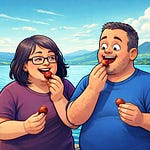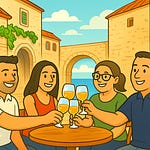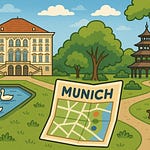**Click HERE to look at pictures and videos from our time in Cologne and Heidelberg**
Both: Hey, everyone!
Jen: It's Jen and Greg with an update on our travels.
Greg: This update is about the beginning of our time in…Deutschland!
Jen: (laughs) Yeah. Germany was definitely one of those places we knew we wanted to visit because it's so iconic - the architecture, the food, the history. We knew we wanted to go.
Greg: However, we couldn't do everything. We were not able to visit Berlin. The Schengen area really puts a time crunch, and we had to make sacrifices somewhere. Unfortunately, Berlin is one of the places we had to cut from our itinerary.
Jen: Yeah, but if we ever make it back to Germany, it's going to be on the list.
Greg: I hope so.
So the first place that we did stop in Germany was a city called Cologne. It's really just an overnight stop for us to break up the train travel, but it has a noteworthy cathedral, which is the main reason we decided to stop.
Jen: Yeah, and I know you're thinking, Cologne doesn't really sound like a German name.
Greg: It does not.
Jen: It's because it isn't. It was actually named by the Romans, who founded the city in 50 AD. And they named it — ugh, I hope I say this right — Colonia Claudia Ara Agrippinensium.
Greg: Yeah, I'm glad you were the one to say it.
So, Colonia - I think - means settlement, and Claudia references Emperor Claudius.
Jen: Yeah.
Greg: But over time, it just became Colonia, which, in modern language, turned into Cologne.
Jen: One of the main reasons we went to Cologne was to see the Kölner Dom, or the Cologne Cathedral. And its formal name is actually the Hohe Domkirche Sankt Petrus.
Greg: Again, better you to say it than me.
Jen: (laughs)
Greg: Uh, but no, I mean, it's this really impressive building, gothic architecture, and it's, like, six million people a year go to see it.
Jen: Yeah, it's, like, the most visited cathedral in Germany, I think. And it's also a UNESCO World Heritage Site, which we visited a lot of those along the way.
Greg: Right. So when you see the pictures, the front facade has two massively huge spires, which made it the tallest building in the world from when it was completed, like around 1880-ish, until the Eiffel Tower was done in 1889.
Jen: Yeah, and those huge spires are very hard to photograph.
Greg: Yes, but they're adorned with magnificent stonework that I'm pretty sure was painstaking and took a long time. Like, I think the cathedral took 300 or 500 years to complete.
Jen: Yeah, it was very pretty. And thankfully, I was able to get a video that kind of pans up from the base to the very top of the spire so you can see some of that ornate stonework and just the great craftsmanship in the whole thing.
Greg: Yeah, for sure. And the inside was just as…impressive.
Jen: (laughs) There it is again.
Greg: I love the word, I guess. But the vaulted ceilings are, like, well over 100 feet high and surprisingly well lit.
Jen: Yeah, that was one thing that we noticed. A lot of the churches that we visited weren't as well lit as this one. And maybe that was because they added on throughout the years that blocked the natural light from the original plan. But this one, the way it stood, was very well lit and very welcoming.
Greg: Besides the cathedral, of course, first stop in Germany, we had to get some German food. We went to a place called Gaffel Am Dom, which had some very tasty food. We had some bratwurst and schnitzel. I even got the local beer, a Kölsch.
Jen: Yeah, which if you know Greg, that fact right there is very surprising!
Greg: Yeah, I'm not a beer drinker. It wasn't, like, a Guinness or even a lager. It's a very light beer, so that was okay. And it's small.
Jen: (laughs) Yeah. The size of that beer looked like a sample size for some people.
Greg: Yeah. Well, like we said, this was just a one overnight stop. The next morning, we hopped on a train and went to Heidelberg.
Jen: Yeah. Heidelberg, during our research, was a place that we decided to go to because it came very well-recommended on the sites for being the kind of charming, picturesque German town that we were looking for.
Greg: Sure. And the car ride from the train station to the hotel was very scenic. But to be fair, that's because almost all of Heidelberg is very scenic.
Jen: Yeah. The Neckar River runs through the city and you drive along and you see these picturesque buildings along these tiny streets and you're in this river valley. So when you look up to the side, you see the hills that are surrounding you and you look up on one of them and there's a castle.
Greg: Yeah, that's Schloss Heidelberg, which we will explain later. But the hotel that we selected is kind of right near the beginning of something they call Philosopher's Way.
Jen: So Philosopher's Way was this pathway that's been around for hundreds of years. And professors at the university, students at the university used to take this walk as more of a meditative stroll, they said.
Greg: So the next morning, we set out early and began our walk along Philosopher's Way. And we really weren't prepared because it's three quarters of a mile to get to the scenic overlook. And we did not realize how much uphill it was. Looking back, it wasn't that bad. We just really were out of shape and didn't expect it.
Jen: (laughs) And I have to add that before we started this walk, we did go to breakfast and had more terrific orange juice. So I think I'm just going to turn these updates into, like, “Jen's world tour of orange juice.”
Greg: I mean, I wouldn't blame you.
Jen: (laughs)
Greg: In any case, you walk the beginning through part of the university. You see some old university buildings, also an old neighborhood with some older homes. And at one point, there was a gentleman, I'm pretty sure was in his late 70s, who walked past us uphill like we were standing still.
Jen: Yeah, that was kind of embarrassing. (laughs)
Greg: Yeah.
So eventually you get past the buildings, you get more into nature, and it's lovely, green and full of life, and there's a scenic overlook with gardens...
Jen: Yeah, and I think this is the point where it hit me. “Okay, this is why it was called a meditative walk.”
You look out over the river and you can see into Old Town and it just kind of brings you back to thinking what it must have been like when they were taking these walks before the buses were coming by or more people came into town. It was just really peaceful.
Greg: Yeah, but I take issue with using the word “walk”. I have an expectation if you call it a walk. It was a hike! (laughs)
Jen: (laughs)
Greg: While we're there at the scenic outlook, the castle across the river, four cyclists come up and speak to us in German. And I just kind of looked at them and with my default phrase, “Sprechen Sie Englisch?”
Jen: (laughs)
Greg: They were like, “oh, Americans!” And they proceeded to visit with us. And they were so happy that we had taken time to visit Heidelberg. And besides that, they were so interested in where else we had been in Germany, where we were planning to go in Germany. It turns out that their initial comment in German was to ask if I would take their picture with the castle in the background.
Jen: Yeah, and I think this interaction was so fun for us because it's really what we wanted when we started to travel. We wanted to be able to talk to local people and kind of connect with them. And I think even the short little conversation let us do that.
Greg: Yeah, and it definitely broke the stereotype you get from TV and movies of how Germans are distant and cold. These people were absolutely lovely.
Jen: So we continued our walk along Philosopher's Way and it began to bring us downhill, which led us to some very old stairs. I would venture to say original stairs.
Greg: Yeah, the footing wasn't great and we weren't in great shape.
So several times we would just have to move over to the side and let the more fit people walk past.
Jen: (laughs) But we took our time and we finally made it to the Old Bridge.
Greg: Right.
So the Old Bridge, I believe the official name is Old Bridge —
Jen: (laughs)
Greg: — in German, of course, not English. But it's from the late 18th century. It's a cobblestone bridge. It's very well maintained and it's very attractive, very visually appealing. There's the big, uh, archway at the end.
Jen: I think it's called the Bridge Gate.
Greg: Yes. And from there, you cross over into Old Town.
Jen: Yeah. And it was really neat to walk across these cobblestones because it was kind of rainy. And so it had that slick cobblestone look and you cross through this gate and it's almost like you're stepping back into time because you have these original looking buildings—I think they were original—and then there's this grand historic church to the side and then you look up to the left on the hill and there's the huge castle. So we just kind of wandered through the streets of the town just enjoying the scenery.
Greg: Yeah, and there were several squares.
Jen: Each little area had its own square filled with statues or fountains and surrounded by these old, original buildings. People were sitting at the cafes enjoying coffee or tea. And it was just really cool to kind of be in that atmosphere.
Greg: Yeah, I enjoyed Old Town Heidelberg. From there, we just walked a couple of blocks to the funicular that you can take up to Schloss Heidelberg.
Jen: So there are two different ways to get up to the castle, and one of them involves a hill and a lot of stairs.
Greg: Nope!
Jen: Yep. That was not going to be the option that we chose after our Philosopher's Way walk. So we chose the funicular, which, if you're not familiar, a funicular is just a cable car that goes up a hillside.
Greg: So we exited the funicular and paid for access to the castle. And right away, you can see this courtyard that has an outlook where you see the river valley. You see Old Town, the Old Bridge. You can see across the river. It was a fantastic view. We spent like, I think, almost 30 minutes there and we weren't the only ones.
Jen: Yeah, I think part of that time, though, was us looking at what we had just walked on the other side of the river and going, “whoa, we actually walked all of that way!” (laughs)
Greg: Yeah, and you know, we figured out the distance afterwards. It really was only about a mile from the hotel to the old bridge. It’s just because of the incline and then the steps on the decline, it felt like so much more.
Jen: Yeah, it definitely was nothing compared to some of the other walking adventures we’ve had. But at that time, it seemed like a lot.
Greg: Yeah.
So an interesting fact about the Heidelberg Castle is in, like, 1764, it was struck by lightning twice, causing a lot of ruin and a fire that destroyed parts of it. And interestingly, instead of just rebuilding it all, it kind of became this thing where the locals embrace nature and the ruins and they kind of try to preserve it as it is.
Jen: Yeah, they had a spot where they can have concerts and they have speakers that come and talk. And like a lot of castles, it has these towering walls on the side of you.
Greg: Some castles are more fortress and militaristic. And then much later, castles took on a more palatial aspect. And this was kind of in between the two. There were areas that felt more palatial, but that definitely had the walls and the overall military fortress aspect.
Jen: Another neat thing for the castle was it had its own apothecary shop, and so it's now an apothecary museum.
Greg: Yeah, and the big draw for a lot of people is this thing called the Heidelberg Tun.
Jen: What the Heidelberg Tun is, is this huge wine barrel that’s probably about two stories high, and it holds over 200,000 liters of wine that were basically the taxes paid by the local vintners.
Greg: Yeah, and you walk up these stairs to get to the top of it, and there's, like, a platform. Apparently that platform at one point was a dance floor. That's how big this thing is.
Jen: It was more of a novelty thing, but it was serving a purpose.
Greg: Yeah, so we pretty much wrapped up things at the castle, went back to the hotel. Our time in Heidelberg was charming and romantic, which is what we expected, and I loved how scenic everything was.
Jen: Yeah, I think Heidelberg was probably my favorite of the small towns we visited in Europe.
Greg: Yeah.
The next update will be about our time in Munich, but we spent five days there, so it's probably going to be two or three updates in a row about Munich.
Jen: So we got to see Neuschwanstein Castle, which was the inspiration for Cinderella's Castle at Disney World. We visited Nymphenburg Palace, which is the former home of German royalty. We saw the English Gardens, which is like Munich's version of Central Park. And we also saw a Glockenspiel.
Greg: Yeah, that's like a world-renowned cuckoo clock, basically.
Jen: That was really fun to see!
Greg: Yeah. So overall, we look forward to sharing our time in Munich with you guys. And…thanks for checking in.
Jen: And we'll see you at the next stop!











